Colonel Joe Chang:
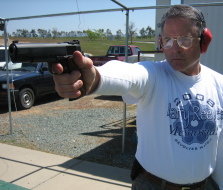 Commander Steve Killingsworth:
Commander Steve Killingsworth:Cecil Rhodes:
Good Vision and Good Shooting to All,
Norman H. Wong, O.D.
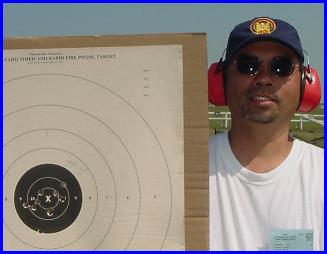
(Ed's Note: Survey finalized/posted in February 2009 - some additions have since been made.)
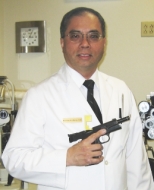 Greetings Shooters,
Greetings Shooters,
Confused about your visual perception of iron sights under the open sun? Most ranges have covered firing points but not at Camp Perry or at the site of the Canton Regionals. Some of the best shooters in the country responded to a survey of two parts. First, do your shot groupings change when shooting under the open sun? Second, a list of questions pertaining to vision and other details were asked in order to determine if there was some kind of common bond to the responses.
PART 1 QUESTION:
Don Nygord's notes indicated that if the sun is coming from the right, the front sight blade will be "blurred" on the right side. This will cause an effect of a thinner apparent right front edge and therefore a wider right gap. When the sights are realigned, errant shots will go to the right.
While shooting with iron sights, do your shot groupings follow in the direction of the open sun?
PART 2 QUESTIONS:
Do you use center mass hold, 6 O'clock hold, or sub-six hold?
OVERVIEW:
Our distinguished panel included National Champions, National Record holders, Olympic caliber shooters, and shooters who are on top of their game. All are High Masters except for two Masters. They are all Distinguished and some have placed on top in the President's 100 and NTI matches. The National Champions include Brian Zins, Steve Reiter and Jim Lenardson; past National Civilian Champions are Dave Lange and Chris Johnson; past National Junior Champion is John Bickar, whose father was the prominent Frank Bickar. Four were members of the Springfield Armory Team. Brian Zins, nine times National Champion, presently serves as the National Manager Pistol Programs, NRA Competitive Shooting Division.
Some other familiar names include John Zurek, Slo cat, Colonel Joe Chang, Scott Lorenz, Tony Silva, Commander Steve Killingsworth, Dr. Rich Kang, and Cecil Rhodes. Two from this group are members of the Ultradot Team along with another un-named shooter.
Surprisingly, two distinct groups developed from the survey. There were a total of seventeen responders, eight who never needed to change their sights for windage (group 1), eight who needed to change their sights for windage (group 2), and one, not sure. Those who needed to change the sights typically moved their rear sight windage by 1 to 3 clicks, and 4 responders needed to adjust up to 5 clicks under more extreme conditions.
No one from group 1 saw the blurred front sight edge due to the side sunlight. From group 2, only two responders noted a blurred front edge on the same side as the sun. Another group 2 responder saw a blurred front sight, but on the "opposite" side of the sun. One responder of group 1 noted that, "I know that the sunlight directionality can affect the perceived appearance of the BULL and thus cause one to compensate with the iron sights in just the OPPOSITE way of your example...light on the right will cause you to shoot left."
CLEAREST AND MOST BLURRED:
Nearly everyone who answered part two replied that the front sight was always focused best, with the rear sight as clear or almost as clear as the front, while the bull was the most blurred. Two replied that the rear sight and the bull were equally blurred.
SHOOTING LENS:
As expected, younger presbyopes in their forties needed a lower plus add to see their sights, usually +0.50 diopter add. Shooters in their fifties and older used a higher add, with the highest being a +1.25 diopter add. The youngest responder who solely shoots iron sights, John Bickar, age 31, has been using a +0.50 diopter add. I recalled a past conversation that he wanted to keep his focus away from the bull. Three presbyopes, ages 50, 52 and 58, do not use any lenses but two admitted that they probably need prescription shooting glasses now.
OCCLUDING OPPOSITE EYE:
The effects of occluding the opposite eye may not be conclusive with this small sampling, but the six who replied in group 1 used either black or white occluders, while one (Jim Lenardson) just simply shuts the eye. With group 2, two shooters do not occlude, five used scotch tape, and one used an occluder of either color.
APERTURES at CAMP PERRY:
Of the six who responded in group 1, none used an aperture. Of the eight who responded in group 2, four used an aperture while three did not, and one used it sometimes.
SUNGLASSES:
Three from group 1 and two from group 2 reported using sunglasses (Polaroid, Transitions, and Vermilion were mentioned). Note that Polaroid filters are standard accessories for some custom shooting glasses such as Knoblochs. Anti-reflection coating was not typically used.
WINDAGE vs. ELEVATION:
There were mixed observations from both groups. Four from group 1 who noted no windage changes noted no elevation changes either when the sun was overhead, but two did. Six from group 2 who noted windage changes also noted elevation changes while three did not. Usually, only 1 to 2 clicks of elevation change was needed.
SIGHT BLACK:
The carbide type was most prevalently used by both groups. Shooters from group 1 used either type of sight black. Six from group 2 used carbide, while one used aerosol, and another sometimes used either type. Brian Zins wrote, "A cigar lighter is great."
Here are some responses from group 1 (no change in windage due to shifting sun):
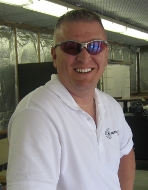
BRIAN ZINS - ten time National Champion, past member of the Springfield Armory Team
Norman,
The biggest thing I notice when shooting irons outdoors is the sunlight effect on elevation more than anything. I feel it is due to the sun on the target more than on the sights. Bright sun at 12 o'clock coined the rifle shooting phrase "lights up sights up" . Kind of the same effect Don Nygord talks about on the front sight.
Brian
Author's note: Having the nine times National Champion taking the time to answer the survey was much appreciated and exhibits the outstanding character of the Bullseye shooter.
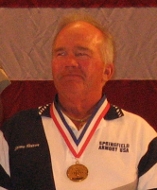
STEVE REITER, five times National Champion, past member of the Springfield Armory Team.
This is strictly my opinion from shooting a lot of years with open sights. I disagree with Nygord. The sun's effect is really more apparent in rifle shooting. There again it has nothing to do with the sights, because you blacken the sights to prevent that.
What the light does affect is the black circle you are putting your sights against. By this I mean it will make the black appear bigger or smaller, which does affect bullet impact. Left or right impact is probably going to be left or right side of the 10 ring depending on the range you are shooting on and how much of an angle the sun hits the target.
This is what I have found works for me:
I have no problem with you telling shooters this is what works for me.
Steve
Author's note: We were fortunate to have a shooter of this caliber (reputation) be involved with this survey.
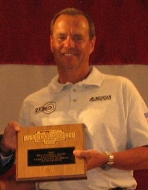
JIM LENARDSON, the last shooter to win the National Matches with iron sights, past member of the Springfield Armory Team.
Dear Norman,
I shot iron sights for 30 years as a high master. Shot 2670 several times with them and never had the sights change with the sun. I am well aware of folks talking about that but never had a problem with it. It always came up at Perry because of facing the North and no cover over-head. Some were adamant about it and others thought it made no difference. Good luck with your study and enjoy the Christmas season!!
Best Regards,
Jim
Author's note: Outstanding credentials with open sights
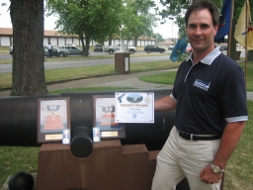
DAVE LANGE, past Civilian National Champion, past member of the Springfield Armory Team
Hello Norman,
I'm glad that you asked this question. I very rarely have to make sight corrections. I have heard all of the complaints at Perry about how the sun changed between the Presidents 100 match and the NTI and NTT matches. I have never noticed this in my sights. This year I heard the same stories. This year was my best year for Service Pistol. My sight settings were the same for Pres 100, NTI & NTT as they were in April and October and at every Service Pistol match I shot this year.
So the answer to your question is No. If I have to make a sight correction it is usually because I am doing something wrong and it is more than likely a change in my grip that would cause me to group in a different spot. If I do make a sight correction for this, I usually have to change back on the next target.
Ditto for International. Indoors and Outdoors.
Please let me know your thoughts and findings.
Thanks,
Dave Lange.
PS. I do not mind if you share my comments.
Author's note: Without Dave's help, this survey would not have been as complete.
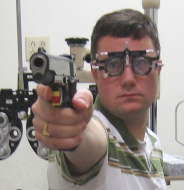 JOHN BICKAR, holder of five National Junior Records, solely iron sight shooter
JOHN BICKAR, holder of five National Junior Records, solely iron sight shooter
Hi Norman,
I've heard the "lights right, sights right" adage but have not found it definitively to be the case. My other responses are inline, below.
JB
CHRIS JOHNSON, past National Civilian Champion
Norman,
I have not noticed shot groupings move with light conditions. Specifically, shooting ball at Camp Perry at 7:00 am then again at 11:00 am does not move my groupings.
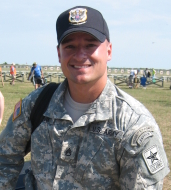
SSG Robert S. Park, AMU Pistol Team, 2010 Presidents 100 Winner and DR Winner (added in July 2010)
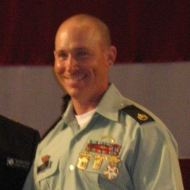
SSG John Ennis, AMU Pistol Team (added in July 2010)
Some responses from group 2 (windage needed changing with the moving sun):
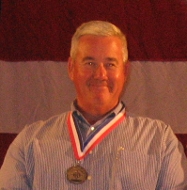
Philip Hemphill, 10 Time Winner of the National Police Shooting Championships, Past member NRA Board of Directors (added in July 2010)
Dr Wong,
It was truly an honor to finally meet you. You are a credit to your profession as well as our sport. My eye doctor here in Mississippi gets a little uneasy when I bring my guns in to his office for sight picture correction. I have found that is the only way I can get a correct adjustment for vision. The light also affects the way I perceive the sights, in his office.
I have been shooting iron sights in PPC for about 25 years. I have found that the glare on the front sight has more bearing on shot placement than the effects of the sun. Our range faces north, the range at Jackson PD faces south. I would have to move 2 clicks left and 1 click down when I went to Jackson P D and shot. The sun was on my left side over there. The sun has a tenancy to push me away from the target.
Thank you for the opportunity to answer some of your questions. I know that I am fairly new to BE shooting, but not to pulling the trigger.
Hope this helps. Thanks again for all that you do.
Philip Hemphill
Range Director
M.L.E.O.T.A.
JOHN ZUREK
Hi Norman, thank you for considering me in your panel.
I often shoot iron sights while training with the Free Pistol. Here in Phoenix, our club is situated so that I am shooting south (north is preferred). When I start a training session, normally I have rounds going down range by 8am, the sun is coming up on my left, I break for lunch at 11:30 and continue shooting till 3pm.
I often shoot for group so that I don't get caught up in moving the sights around in training. In the morning my grouping is to the left, then as the sun centers in the sky my grouping is centered, and when I train in the afternoon, my group moves to the right.
My theory has always been that the sun "shines" on that part of the front sight (left or right) causing a greying effect, which makes the mind move the sights in that direction to make up for the gap.
A solution is to close the rear sight gap, allowing less movement. Or to shoot in a dark covered tunnel where the light cannot affect the sights...
Good luck and drop a line anytime,
John Zurek
Another note that I failed to consider with all this talk of the front sight. When the sun comes up on the left of the target (and we get a lot of sun here in Phoenix), the light shining on the target gives the appearance of the target elongated to the right, then the sun centers in the sky and the bull is elongated down (sun's up sights up ). As the sun starts to set to the west (right) the image of the bull "drips" to the left - all of which cause my grouping to shift as I shoot. When one is fixed on the sights the "black thing" downrange is blurred to the left or right due to the sun's position.
JZ
SLO CAT (Steve Locatelli)
Norm,
The only places I shoot service pistol in direct sunlight is at the Canton Regional, the NRA Whittington Center, and Camp Perry. Yes, I do notice that the groups do tend to move towards the direction of the sunlight. It is more noticeable to me at 50 yards than at 25 yards.
My take on the reason this happens is: My eye is trying to center the front sight in the rear sight notch, and in doing this, I unconsciously move the front sight toward the bright side to even out the perceived light on both sides of the sight blade. I have not noticed an elevation change when the sun is directly overhead, but I will always adjust my sights to correct an errant group, even if I don't know why the group is errant. I do not notice that the bright side of the front sight is 'blurred'.
At Camp Perry, the President's 100 match usually starts at 0700 hrs. with the sun low on our right side. I adjust two clicks left. During the NTI later in the morning, I take out these two clicks. In the afternoon team matches, I adjust two clicks to the right, as long as there is still direct sunlight. Overcast conditions usually are the same for me as shooting from a covered firing line.
Best Regards,
Slo cat
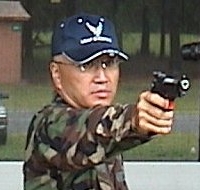 COLONEL JOE CHANG
COLONEL JOE CHANG
Thanks Doc. It was an interesting drill. My iron sights always have been different than other shooters'. When I pick up someone else's ball gun, I wind up shooting high into the 8 ring. In fact, my ball guns and iron sight .22 have modified front sights. In my mind I am doing alignment as we have been taught...no different. I decided go with it.
As for Camp Perry, you might ask how many actually use sight black. I have not used it regularly. I just made sure front sight was clean. I use serrated front sight and sometimes I do see the front sight being more gray than black. Maybe reflections from the front sight which might distort the way I see it. Again, I decided not to analyze and go with it (means I adjust my sights to center my group).
Your survey was an interesting one. You got me thinking... I will have to watch for it when I shoot it next time.
Regards,
Joe Chang
SCOTT LORENZ
Hi Dr Wong,
When I first read Don's notes on this subject it confused me because it's opposite of my experience shooting BE & PPC on open ranges. Don was a very smart man, so I just figured I was the odd ball. I'm excited to read about your findings!
My experience is that, the side of the sight facing the sun has direct light on its side so my eye sees it very clearly. The side opposite has reflected light which makes it fuzzy, thus appearing wider on that side. My eyes adjust the light gaps equally on each side of the rear sight (an unconscious act) and the groups are always toward the sun side of the bullseye (using my normal zero).
When shooting irons and dots I keep both eyes open............I believe using both eyes enables me to triangulate on the front sight giving way better depth perception.
At Perry I always adjust 2-4 clicks away from the sun on my first shot. Always more clicks the earlier in the morning and less as it aproaches noon.
Thanks,
Scott
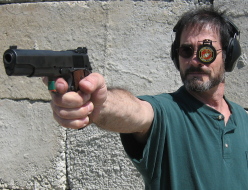
TONY SILVA, member of the Ultradot Team
Hi Norman,
I don't notice anything visual or I am not paying attention to the visual difference of the blurring sight. I think I look at the top of the front sight when shooting irons. I do notice however the difference of where the group is, for example. I shoot friday afternoon and am centered on the target. Then next day shoot earlier in the day and I notice the group has changed from the center and I have to adjust the sights. I am aware of the "lights up sights up" anomaly.
CECIL RHODES
Norman: Thanks for the inquiry. I had to review my notes from quite a few years ago when I was exclusively shooting iron sights. I shot open sights for several years, eventually breaking 2600 and then 2620, then switched to dots. I typically used a 6 o'clock to sub 6 hold, depending on conditions.
I shot on quite a few ranges with different sun and lighting orientations, but only shot about 3 different guns over that time. A couple of High Standards and a Bomar Rib 1911. Now, the reason for mentioning the guns in important.
High Standards (early ones) will typically have thinner front sights. Mine had about 0.100 inch for the High Standard and the front sights on the 1911 ribs is about 0.125 inch.
Anyway, this is important in that the lines of white or spacing of the front and rear sights is slightly different and the width of the lines of white seemed to make a difference.
Item 1. Light up, sights up is pretty much true everywhere. The brighter the ambient light, the smaller the bull looks, but the spacing on 6 o'clock hold looks different as well. Mostly this seems to be the reflection off the top of the front sight using a 6 o'clock hold. The sub 6 o'clock was not affected as much, but it would vary sometimes.
Item 2, The biggest factor in horizontal problems was the effects of shadows or partial shadow on the targets. Bristol, TN range had a small mountain as a backstop and the targets were in the shade until about 11:00 every day. Durham, NC was bad about having slightly curved targets which made half the face in the shade in the mornings and afternoons. However, I did find in my notes that I shot my first clean at the short line (with a .22) in a driving thunderstorm where we couldn't really see the targets and it was almost pitch dark.
Item 3. When the sun is on the extreme left or right (like first relay on CMP day at Camp Perry) this will produce a tendency to open up the bars of white towards that side due to the reflections from that side of the front sight, (at least for me). I think that is what Don was talking about. However, with the thinner front sight on the .22 (and larger bars of white), this effect was not seen as much.
Therefore, by the time I was finished, I had notes for the sight settings for various ranges and lighting. But the most important was that early relay sight setting at Camp Perry. There were definitely clicks needed to start and come off as the light increased with the 1911 ball gun.
So one data point you probably need to check the ratio of light to black (width of bars of white) on the sight picture along with any other comments. It seemed to make a difference for me.
Cecil
DR. RICH KANG, Ultradot Team member
Norman-
I have tried to make a clear and reliable association between the position/brightness of the sun and the need for zero change with iron sights. I have not been successful. In practice if the conditions are REALLY bright or dark, I do use the "group follows the sun" theory, but only a click or two (to start with) using Bomars.
I shoot center hold with irons at 25 yds. always, and have found that any zero change is much less important than other technical errors (and I have cleaned the rapid target with both DR and .45 svc pistol in matches). At the long line, I have gradually switched to center hold with .45 and DR. I do understand the advantage of "center is always center", but I also believe that this "fact" is mitigated somewhat by the change in the perceived size of the bull with changing light conditions.
What really ends up happening when I shoot "center" is that I like to see somewhere between slightly more than half to 3/4 of the bull (i.e. I always like to be able to "see', not look at, the bull's equator) because, if I shoot a true center hold, I have significant insecurity about being too high on the bull because I can't tell where the equator is (i.e. if I'm at or above the equator, and because I'm not looking at the target, the bull is fuzzy enough that I can't tell if I'm at the "fat" part of the bull or not; i.e. (again) I can't tell the difference between seeing 50% of the bull and 1/3 to 1/4 of the bull over the front sight.)
In any case, I used to shoot a subsix with these guns and between the change in perceived bull size and resultant change in the light gap (I shoot a very deep sub six (at least halfway between the bottom of the bull and the bottom of the paper)), but changed because of the wildly changing zeroes day to day and with different light. I still use a deep subsix for air pistol and free pistol because of the need for greater precision wrt sight alignment with the smaller targets and because of the usually more consistent light conditions indoors. Additionally, the sights on int pistols are so much better, larger, and therefore "clearer", that they dominate the sight picture and there is less of a tendency to switch focus to the target.
Sorry for the big ramble... So in answer to your question, as I said, I do use the "group follows the sun corrections" to start with in extremes of light change (e.g. Perry), but usually rely more on calling a good first shot or two and correcting from there, as, for me, many more factors than just light variables affect my zero on any given day.
I think, in general, a narrow gap is problematic for all but those with exceptional vision (like some of those crazies who don't need a spotting scope at 50y). I believe there is a perception (and I apologize if this is obvious to you (or maybe it's just wrong) - I really am not trying to be patronizing... :)) that a narrow gap will allow less error because if you see any light at all on either side of the front sight, your sights are aligned.
Most people, myself included, can't actually hold perfect alignment (and I think I have a pretty good hold), so that there is a tendency to try to control the shot and, even if only slightly, jerk the trigger and knock the "average" ok or good sight alignment out of whack - this tendency is worse with a narrow gap because the perfect alignment is much more "fleeting". Of course one can't see that the trigger has wrecked the sights because of the gun's recoil.
With a wider gap, the "alignment wobble" is less perceptible and allows less concscious/subconcious "panic" thereby allowing smoother trigger control. This in addition to the actual visual process that Nygord wrote of about a wider front sight and gap firing off more retinal cells which allows more data for the brain to process. For me, a really narrow gap (as the Bomar's with the standard front sight width) is sort of hard to shoot. It's easier with good light, but with a side glare, I just can't tell what's going on and I have difficulty with a smooth trigger pull because I can't trust what I'm seeing because I'm trying to account for what I think is the brighter side and it's hard therefore to accept the wider light gap on one side as being "right".
With the wider gap, I see less alignment wobble and I trust that "mathematically" my eye will be able to "average" more effectively (despite the one sided glare) and I can just work the trigger. I know that the wobble isn't actually any different, it just seems less so there is less psychic stress which causes problems with the trigger pull (i.e. start, stop, start, etc. as opposed to an appropriate smooth steady squeeze); plus I think the centering (light gaps equal) IS actually better (per Nygord's theory).
This year I have worked really hard on making a smooth steady unwavering inevitable inexorable trigger squeeze my absolute priority almost disregarding all but the most heinous misalignment and have found that ok alignment is good enough when the trigger does not disturb it. (I think that in the development of shooting skill, a shooter goes though rough stages: 1) work (jerk) the trigger to "pick" a shot when the sight picture is good (the error being that the shooter is looking at the target and thus really doesn't know if the sights are truly aligned); 2) work the trigger when the alignment is good (the error being that the alignment is not what it was when the brain decided to commit to the trigger); 3) working the trigger while working the sights with the two processes being almost independent (where I am now); 4) working the trigger perfectly while the subconscious aligns the sights timed to the trigger. Sights first always loses.)
Anyway, I have found (especially with the air pistol), my scores are the same or better with trigger emphasis; it's easier to break the shot psychologically, and, in observing and being aware of what's going on during the shot process, that sight alignment, though obviously important, is less so than a good trigger because a good trigger will not mess up the sights, while a bad trigger will mess up perfectly aligned sights and make ok alignment terrible.
I think the answer to the question you asked is buried in there somewhere. Sorry for the ramble; I appreciate the "forum" in which to do so. I do think about this stuff quite a lot and I guess it all just fell out (hope you're not sorry you asked!).
Rich
Author's note: Thank you Rich for the detailed explanations. Many pearls revealed.
SUMMARY:
I wish to thank everyone for their replies and sharing their expertise. With no disrespect to others who have different viewpoints, this was how our shooters saw. There were recent discussions on the Bullseye-L Internet shooting site of the blurred front sight edge (on the same side as the sun) due to Refraction/Diffraction but the survey seemed to indicate otherwise. Almost all shooters saw a clear front sight in spite of the sun, counter to Don Nygord's notes. Two shooters who saw the blurred front sight may possibly be explained by not having updated prescription/add lenses. Glare on the front sight edge was reported by many from group 2 but not from group 1.
Of interest, the six national champions all belong to group 1 and saw their front sights with no edge blur, no report of edge glare, all used either a black or white occluder (one shuts the eye), no one used tape to occulde nor kept both eyes opened, and no one used an aperture.
My personal experience has been limited with shooting under the open sun. I have noticed while conducting this survey that if the early morning sun was coming from the side, there was a clear line of glare on the front blade edge depending upon whether the sun was coming from the front of the pistol or behind the pistol. It was very angle specific. A fresh coat of sight black reduced the glare.
Brian Zins, Steve Reiter, John Zurek, Rich Kang and others mentioned the sun affecting the perceived target appearance. Besides the size of the bull changing with the sun, the change in shape of the bull was noted by Zurek. Steve Reiter wrote, "The ball is a round ball, if it isn't you'll have grouping problems." Center mass hold and 6 O'clock hold were equally preferred from group 1. The majority of group 2 preferred center mass hold.
There were no concluding consistencies I could draw from the use of plus add power lenses, tints, anti-reflection coatings, and apertures. Recall also in the "Results of the Red Dot Position Survey" that some shooters saw the red dot on the same plane as the target while others saw the red dot in front of the target. Peoples' perceptions vary. All used sight black except Dave Lange for the service pistol because Dave saw the serrations better without the sight black. So, using or not using sight black didn't appear to be a factor to explain why the difference between the two groups.
In general, my recommendation has always been to obtain the best focus for the front sight, followed by the rear sight and then the bull. How blurred is considered acceptable can be shown by your eyecare professional. Note that Brian Zins and Cecil Rhodes preferred to have equal blur of the rear sight and the bull. But Cecil also wrote, "....I shot my first clean at the short line in a driving thunderstorm where we couldn't really see the targets and it was almost pitch black" Again, this demonstrates the importance of sight alignment and trigger control we've heard time and time again.
Shooters in their fifties who do not use a plus add may not be seeing as well as they think. As described in my "Bullseye Shooters' Guide for the Eyecare Professional," younger shooters who are not presbyopes may be helped by blurring the bull with the use of a small plus add, such as John Bickar uses. A recent shooter's eye exam for John Bickar revealed 0.75 diopter of myopia in the shooting eye, so the total resultant add including his +0.50 diopter shooting lens becomes +1.25 diopter. John feels that anything less takes his attention away from the sights. Once again, a clear bull is not essential for shooting well. I believe from talking with top shooters that if one needs to see the bull well, that shooter has not developed confidence with his or her trigger.
When one has difficulty with the sun, try different tints (note Dave Lange's comment about Camp Perry and the bright targets) and anti-reflection coatings (recently described in the November 2008 issue of the American Rifleman). Apertures are used to increase depth of field but they can also decrease the brightness (white) of the target when too sunny. Try different methods of occluding or even perhaps keeping both eyes open. What may work for one shooter may not work for another.
I intentionally had saved Rich Kang's responses for last because of his summary on the importance of trigger control. It would be wise for the novice shooter to remember that 1 click of windage adjustment of the Bomar rear sight is approximately 3/8" at 50 yards. With two clicks to the right or left of the "X" during a leg match, the shot would still be within the X ring (with five clicks the shot would still cut the 10 ring). Quoting Dave Lange, "If I have to make a sight correction it is usually because I am doing something wrong and it is more likely a change in my grip that would cause me to group in a different spot." Dave was from group 1, and Rich was from group 2.
There may be some correlation with the rear gap width in relationship to the front sight width affecting the perception of the sight alignment. Not enough responses were received though. Some preferred a wider rear gap or a narrower front blade. Some examples of rear sight gap widths and heights, and front blade widths are noted next to show the variety of gap proportions.
VARIOUS SIGHT DIMENSIONS OF DIFFERENT PISTOLS:
(I tried my best to be as accurate as possible and these were unaltered sights)
I seem to note three catagories which may be a good future topic:
The Eliason and Bo-Mar slits will appear narrower. A few of the respondents did not like this narrower gap and needed to open up the gap. Bickar prefers a little more "wiggle room." Although slight, the sight radius of different pistols will affect the perceived slit gaps; the longer the sight radius, the wider the slits. Shooters with longer arms and those who shoot with a more open stance and therefore a longer reach, will find that the slits appear narrower than those of their counterpart fellow shooters who have a shorter reach. I can just imagine how narrow the slits may appear for Ed Hall who many of us know has a very, very long reach.
Of course, all this talk is purely academic if one does not employ good trigger control fundamentals as taught during the Brian Zins/ Andy Moody Bullseye clinics and which is a continual topic in Bullseye-L. During an NTI match, if one fires the first round significantly away from the X ring, it most likely is not due to the sun. I decided to conduct this survey after a master class shooter became confused with his sights between the President's 100 and the NTI matches at Camp Perry last year. From the results of this survey, only 1 to 2 clicks may be needed for elevation, 1 to 3 clicks for windage but perhaps as many as 5 under more severe sun lighting conditions. It is important to note that many do not need to adjust their sights at all.
My hope with this survey is to provide some guidance to shooters (including myself) of all levels using iron sights by relating how some of the "best of the best" see under the open sun. There is something valuable from each of the shooters' responses. The generous sharing of personal experiences may best be summed up by Steve Reiter, "I have no problem of you telling shooters this is what works for me!" If anyone has contacts to other top shooters I would welcome their input to this survey and to provide a future addendum. Hershel Anderson, Babe Magnan, Jim Henderson???
Here are some additional acccomplishments by a few of the responders:
John Zurek: Commander Steve Killingsworth:
Commander Steve Killingsworth:Good Vision and Good Shooting to All,
Norman H. Wong, O.D.
